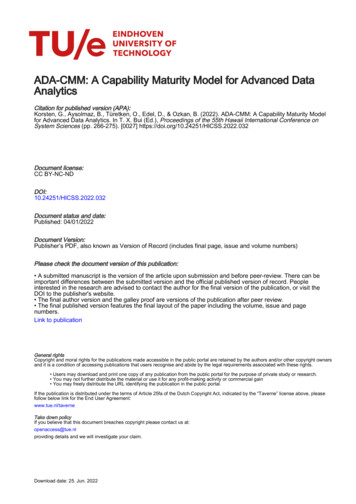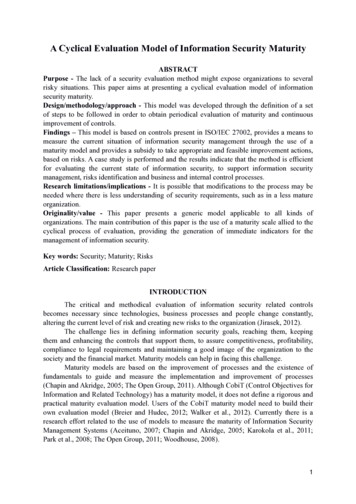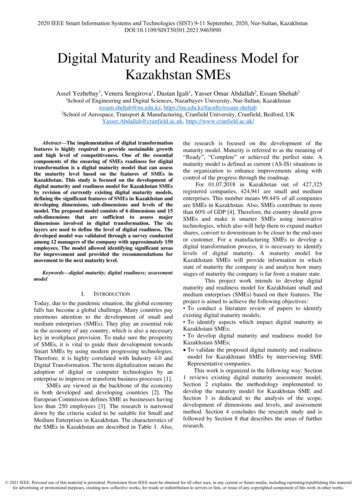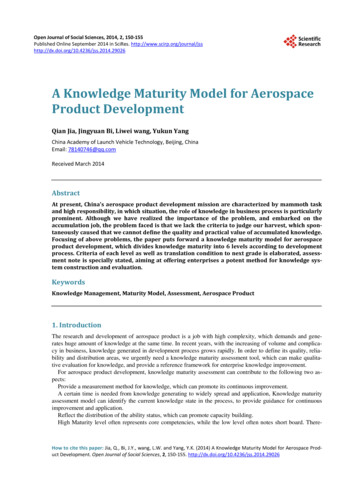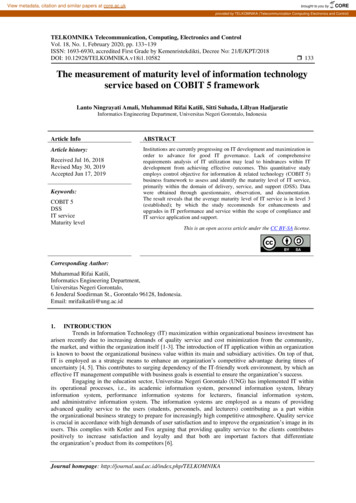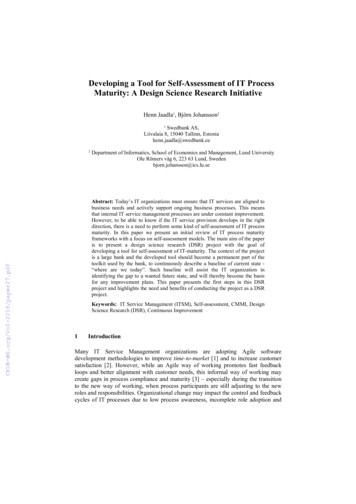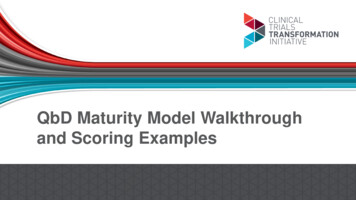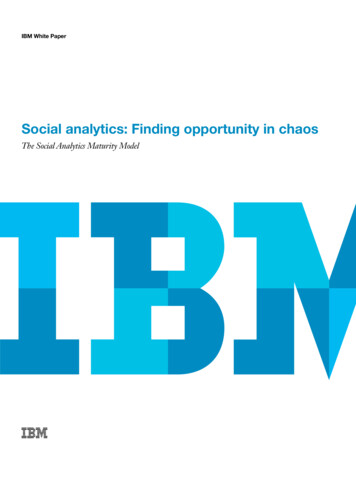
Transcription
IBM White PaperSocial analytics: Finding opportunity in chaosThe Social Analytics Maturity Model
2Social analytics: Finding opportunity in chaosContents2Introduction3 How mature is your organisation’s ability to analysesocial media?3 The Social Analytics Maturity Model4Social Analytics Maturity Model: a detailed framework5 Using the Analytics Quotient to measure your socialmedia analytics capability8Conclusion8Next steps8How IBM can help8IBM Business Analytics8IBM Social Media Analytics9For more informationSummary: Finding opportunity in the chaosAll organisations are engaged in social media – eitheractively as participants or passively as a topic of discussion.Enterprises can no longer escape the need to monitor andanalyse social media outlets such as Facebook, Twitter,Pinterest, news sites, blogs, forums, video sites andmicroblogs. To successfully embrace social media as the‘new normal’, enterprises need to develop a social mediaanalytics capability.Social media analytics is the process of accessing datagenerated on social media such as ideas, sentimentsand customer feedback. This information can then beanalysed and fed into the decision-making process acrossall business activity, including campaign orchestration,product development, recruitment, customer advocacy andengagement processes, sales input and much more.IntroductionFollowing the development of the internet in the 1990s,we saw a second stage of innovation that began in themid-2000s. We believe that this second stage is differentbecause social networking and communities, rather thannew technologies, began driving the global growth of thenetwork. Social networks are reshaping how consumerspurchase products, how they interact with each other and,increasingly, how they lead their lives.Today, the reality is that customers increasingly own theconversation about products and services – and enterprisesneed to adjust. We have entered a period where peer orexpert influence is far more important to customers makinga purchase than the advice of a retailer or a manufacturer.In fact, vendor input now accounts for just 18 percent of thefactors influencing the consumer’s purchase decision.1Businesses often confuse their own desire for customerintimacy with consumers’ motivations for engaging. Theyneed to realise that most consumers do not engage withcompanies via social media to feel connected. It turns out thatcustomers are far more pragmatic when engaging in socialmedia and expect experiences that deliver tangible value inreturn for their time, attention, endorsement and data.2Enterprises must adjust to this change quickly or riskfalling behind. So how can enterprises navigate this newenvironment? How can they generate brand affinity ifcustomers say they are put off by obvious marketing tactics?What does it mean to cultivate a community and maintainloyalty in these turbulent circumstances? And, if peers andexperts are so critical to customer opinions, how can welocate these influencers and productively engage them?IBM’s Social Media Maturity Model offers best practicefor organisations’ social media analytics capabilities. Thiswhite paper outlines the Social Media Maturity Model andprovides a framework, known as the Analytics Quotient,against which you can measure the maturity of yourorganisation’s social analytics policies and procedures.1.2.IBM Institute for Business Value, Capitalising on the Smarter Consumer,February 2011.IBM Institute for Business Value, From social media to Social CRM: Whatcustomer want. The first in a two-part series, February 2011.
IBM White PaperHow mature is your organisation’s abilityto analyse social media?3The Social Analytics Maturity ModelIBM has helped organisations around the world developintegrated social analytics for many years. Over that time,we found enterprises typically go through two ‘waves’ ofprogress on their social media analytics maturity journey.‘Social analytics maturity’ is a measure of a company’sprogress as it moves from accepting the presence of socialmedia as a marketing channel, to continuously leveragingsocial media to improve all facets of its business.Wave 1: Laying the foundationThis white paper introduces IBM’s new Social AnalyticsMaturity Model, which organisations can use to measurehow well their social media strategies are working. It thenoutlines how you can improve your social analytics maturitylevel by implementing the suggestions outlined in IBM’sAnalytics Quotient.Organisations in this first wave range from those that aretaking the first steps in using social media, through to thosethat are actively monitoring and responding to online activity.IBM measures social media analytics activity in threelayers, which we refer to as the ‘maturity journey’:Businesses typically start riding this wave after allocatingbudget to creating a social media presence. At this stage,minor incidents that generate negative feedback can promptproduct marketing and brand management teams to opposefurther development. Social monitoring (listening): Listening in on socialmedia for mentions of items of interest such as brandnames, campaigns, product feedback and competitiveelements.However, once an organisation has shrugged off its earlyfears, it starts to embrace social media. Its focus shiftsto actively acquiring fans and followers and it will oftenengage consultants to help grow its popularity. Social analysis (thinking): Analysing the data capturedduring the monitoring process.Wave 2: Taking the lead Social engagement (doing/acting): Choosing actionsbased on social media data analysis such as input intointernal processes or market engagement.This is the next wave, where a social media presencebecomes integrated into an organisation’s businessprocesses. All information acquired through social mediais captured in the organisation’s systems and aggregatedwith other data for management decision-making. Inthis case, the social media information is invaluable tothe organisation’s understanding of how the broadercommunity perceives it.Figure 1: The Social Analytics Maturity ModelWave 2:Taking the leadWave 1:Laying the tepresenceActiveacquisitionActive monitoringand responseTimeIntegratedpredictivemodelling
4Social analytics: Finding opportunity in chaosSocial Analytics Maturity Model:A detailed frameworkTactical monitoring and responseAs enterprises move through the various stages of the SocialAnalytics Maturity Model, three steps in the maturityjourney remain constant:Active monitoring and response is the last step in the firstwave of the Social Analytics Maturity Model. It involves layingdown the foundation for tactical, campaign-centric planningwith basic filtering of keywords and streamlined content.At this stage, IT may have strung together some quick winsto placate the sceptics but are keen to move faster. However,they may be held up by limited datasets, a lack of historicaldata, and ad-hoc, siloed analytics capabilities. social monitoring (listening) social analysis (thinking) social engagement (doing/acting).Table 1 outlines activities that typify each stage of maturityin an organisation’s social media analytics capability.Table 1: Social Analytics Maturity Model frameworkWave 1Tactical monitoringand responsesWave 2IntegratedengagementPredictive insightsOptimisationMonitoring(Active listening) Basic filtering withkeywords Anecdotal businessinsights Campaign-centric focus Streaming content Analytics-assisted filters –ranking and prioritisation Quantitative businessinsights aligned tobusiness strategy Rules-based eventgeneration Mix of both social andlimited 'traditional' data Model-driven filters –scoring and prediction Forecasted businessinsights aligned to agilebusiness strategy Extensive mix of socialand 'traditional' datasets(internal/external) Optimisation-driven filtersfor ranking, classification,prioritisation and routing Adaptive businessstrategy driven byoptimisation engine Deeply and seamlesslyembedded into businessapplications andprocessesAnalytics(Thinking) Categorisation (#s, %.) Minimal integration ofsocial profiles Limited datasets, narrowwindow of historical data Ad-hoc, passive Text Mining (sentiment,network analysis) Micro-segmentation withrich social profiles Geo-spatial/platformanalysis Cross analysis with nonsocial data Basic view of individualentities Rich temporal analyticsof content, people andcommunity interactions Predictive modellingwith full integration of'traditional' datasets Robust entity propensitymodels Social influenceroptimisation Domain processoptimisationEngagement(Doing) Tactical responses asopposed to leading Limited socialperspective, one-size-fitsall broadcast messages Automated engagement Personalised engagementvia social profiles Segment-specificbroadcast messaging Integrated with traditionalbusiness processworkflows Multi channel,conversation-specificengagement Recommendation-drivenengagement strategy,measured by desiredbusiness outcomes Direct entity engagementbased on propensitymodels Business outcomeoptimisation Marginal return-oninvestment optimisation Targeted crowd sourcing
IBM White PaperIntegrated engagementIntegrated engagement is the first major step of moving intothe second wave of the Social Analytics Maturity Model.The biggest differentiator in this stage is moving away fromall data remaining in third-party Software-as-a-Service(SaaS) applications to bring the data into your organisationfor richer, more targeted analytics – typically with thelonger-term vision of automation.The execution of the integration step in itself would bemanaged by the IT department in conjunction with thebusiness users. IT needs to redesign their existing dataasset structure (such as data models, metadata, master datamanagement strategies and customer records) to allowfor this new influx of raw or, more typically, post-analysiscustomer information.Predictive insightsAt the predictive insights stage, the organisation’s socialmedia presence is integrated into business processes. Allinformation acquired through social media is captured andaggregated with other data for effective decision-making.OptimisationOptimisation is the final step in the second wave ofthe Social Analytics Maturity Model. This stage seesthe complete integration of social media into businessapplications and processes. The organisation can deriveinvaluable input, such as a clear understanding of how thebroader community perceives it.Using the Analytics Quotient to measureyour social media analytics capabilityOnce you have analysed where your organisation sits withinthe Social Analytics Maturity Model framework, you canapply IBM’s Analytic Quotient (see Figure 3) to determinehow you can improve your business and outperform yourcompetitors.The IBM Analytics Quotient (AQ) measures how ready anorganisation is to apply insight to its strategy, processes andtactics; how quickly it can reallocate resources and reorientemployees to make better decisions; and how effectively theorganisation can act based on how well management knowsthe company’s past performance, current results and futurepossibilities.The Social Analytics Maturity Model aligns to the AQmodel. Organisations that have embraced social mediaanalytics as a fundamental part of decision-makingprocesses will have a higher AQ score (see Figure 2). Thehigher your social analytics AQ score, the more likely yourorganisation is to achieve better business outcomes.You can take the AQ quiz online at:ibm.com/software/analytics/aq/.Figure 2: IBM Analytics QuotientStep 4:MasterStep 3:LeaderStep 2:BuilderStep 1:NoviceManual, slow, error prone,cumbersome, fragmenteddata quality concerns5Automated, instant,accurate, seamless,converged datagovernance is in place
6Social analytics: Finding opportunity in chaosFigure 3: Social Analytics Maturity Model mapped against the Analytics gBuilderBusinessValueAd HocanalysisIntegrationNoviceActivemonitoring andActive Wave 1:Set-up and monitoringWave 2:Analysis and optimisationTimeThe NoviceIn the social analytics world, at the first level individualsor teams analyse their own social data, typically usingspreadsheets or basic query tools. There is only a limitedhistorical view into past information.At this stage, an organisation’s focus is on building a socialpresence, with monitoring being the main objective. Aschallenging as the ‘Novice’ stage is to operate within, thegood news is that it’s also the easiest one to get out of. Everyorganisation begins its social analytics journey at this stage.The BuilderThey have formalised a centre of excellence with roles andresponsibilities, a shared service environment, standardtechnologies and processes, and a strong community ofstakeholders who regularly evaluate and revise strategiesand priorities.The MasterOrganisations that have reached a ‘Master’ level of socialanalytics have social media ingrained in their strategy.Master organisations can set top-down goals and allocateresources based on strategic priorities and real-time insightinto shifting online social dynamics.Organisations that reach the ‘Builder’ stage are makingtheir first foray into a collaborative social analyticsenvironment – albeit mostly within a single department.This is typically the marketing function. Teams are movingbeyond setting up presences and looking at basic metrics,such as the number of fans or followers they have, to activelistening and responding.Everyone – regardless of their role – knows the objectivesand how they can collaborate across the organisation toachieve them using social media. This can be by using socialmedia as an active channel to market or to provide support,or using it as a measuring rod for all decisions. Either way,various teams know how social media can be used and howit affects the organisation.The LeaderDecision-makers have the information they need attheir fingertips, whether they are in the boardroomevaluating strategic moves based on social analytics-basedrecommendations or in customer-facing roles makingsales offers based on automated feedback systems. Atthis stage, analytics-driven decisions are no longer theexception, but the rule.The first thing that typifies a ‘Leader’ organisation is thefact that social analytics has gone beyond an external view ofsocial data, to deep integration with internal organisationaldata. These organisations are typified by C-level socialaccountability, with defined operational and financial metricsacross more than one department. Leader organisationscombine social data with data from various systems to achievea cohesive view of insights and opportunities.Table 2 applies the Social Analytics Maturity Modelagainst the AQ.
IBM White PaperTable 2: Aligning the Social Analytics Maturity Model to the AQ frameworkThe NovicePeopleThe BuilderThe LeaderThe MasterPeople driving change at thisstage are the visionaries whooften form a select group inan organisation. They displaya genuine passion for socialanalytics.As the organisation matures,new role(s) are created that focuson social monitoring, analysisand engagement. These couldbe internal head counts orstaffing from external sources.Integration of social KPIs inleading functional responsibilities.KPIs lead to formal training andmentoring for people to acceptand use insights from socialmedia analytics.Personal initiatives drive thelearning curve – social analyticsis probably not a core part oftheir job description.There is an explicit managementfocus on social media analytics,including some limitedperformance measurement ofsocial engagement.Job descriptions includecapabilities around monitoring,analysis and engagement.People in Master organisationshave fine-tuned their skills. Theyuse social media analytics todrive their own activities, aswell those in their sphere ofinfluence, to actively improveand innovate the business.There is an occasional andisolated focus on social mediainsights, typically within currentjob functions, and with limitedsupport from management inthe form of resources and time.ProcessMarketing teams start todiscuss structured processesfor social media analytics.There is no alignment to topdown strategies.Managers initiate budgetconversations around theinclusion of social mediastrategy in business plans.Organisations in whichexecutives see the importanceof social media will mature morequickly than their industry peers.Initial KPIs are put in place,typically around stand-alonecounts such as the number offollowers or fans.External consultants or internalheadcounts are introduced toown and develop social mediastrategies.Organisations start building apresence on social media.PlatformPolicyNovice organisations use adhoc and disparate technologyplatforms. At this stage, staffconducting social mediaanalytics do so with manualprocesses.Novices establish reactive andunclear social media policies.Staff do not understand or fullyadopt social media policies.Senior managementencourages and rewards socialmedia eminence and skill-setthrough annual review processand formal rewards/recognition.By this stage, social media isconsidered a major channelin an integrated marketingstrategy. Social media analyticsas the backbone to mostbusiness functions.Leaders set top-down goalsand analytics drives socialmedia engagement strategies.A feedback loop providescontinuous processimprovement.Builder organisations havea coordinated set of socialmedia analytics tools, which areorganised by business unit.Organisations have employeeswith industry-leading eminencedue to comprehensive socialmedia training.Organisations allocateresources based on strategicpriorities and real-time insightinto the shifting dynamics ofsocial media.Master organisations are clearon their social media objectivesand how staff can achieve them.Social media analyticsare a key input into theorganisation’s continuousimprovement processes.Social media analytics is woveninto the fabric of all decisionmaking processes.Depending on the size of theorganisation, platforms at thisstage may be cloud-based, buthave no integration into internaldata systems.Leaders use a flexible,‘pluggable’ framework toanalyse social media, whichdelivers the right information tothe right individual in the rightcontext. Analytics tools areembraced by the organisationand are used to developinfluence, eminence andthought leadership.Social media engagementpolicies are technology- andmedium-neutral and areadequately embedded acrossbusiness units.Leaders have a functionalsocial media policy to protectthe organisation. Policies areclear around marketing, publicrelations and employee use.Agile social media policyallows staff to engage in socialactivity as part of their everydayactivities to innovate andimprove business.Public relations involvementincreases. PR staff developa clear employee socialmedia policy.Masters can immediatelyidentify and engage in only themost beneficial social mediarelated ventures.Dedicated social media staffintegrate and automate socialThe organisation uses predictive media tools to make it easier forstaff to use.analytics to align social mediadata with traditional businessdata and metrics.Management uses patternidentification analytics tocontinuously improve socialmedia policy.7
8Social analytics: Finding opportunity in chaosConclusionHow IBM can helpEvery tweet, shopping cart purchase, blog post or angryvideo rant is a mine of valuable data. To glean insights fromsocial media data, organisations must capture, manage,store and analyse only the most relevant information.IBM Business AnalyticsOrganisations are coming to terms with how to access andanalyse relevant social media data. As they move throughthe stages of social media analytics maturity, they becomemore adept at predicting market movements and areincreasingly agile in their response. In the coming decade,social media analytics maturity will be a core competitivedifferentiator.Next stepsRegardless of where you are in your social analyticsmaturity journey, we recommend following these steps:1. Take stock of where you are in the social analyticsjourney and identify where your organisation ispositioned in the Social Analytics Maturity Model.2. Use the Analytics Quotient to measure and identify nextsteps you can take to develop your organisation’s socialmedia analytics capabilities.3. Form a social analytics competency group that includesmembers from all areas of the business includingmarketing, product development, human resources, ITand data analysis managers.IBM Business Analytics software delivers complete,consistent and accurate information that decision-makerstrust to improve business performance. As a comprehensiveportfolio of business intelligence, advanced analytics,financial performance and strategy management, andanalytic applications, these tools give you clear, immediateand actionable insights into current performance and theability to predict future outcomes.Combined with rich industry solutions, proven practicesand professional services, organisations of every size candrive the highest IT productivity and deliver better results.IBM Social Media AnalyticsIBM Social Media Analytics is the industry's most robustenterprise-class social media analytics application. It helpsorganisations listen to customers, identify trends andcontent authors, and identify and act on issues before theyescalate.IBM Social Media Analytics enables you to: Grow your business: Understand customer needs andtarget new offers and products to grow revenue. Enhance your organisation’s reputation: Evaluate yourcorporate reputation and make evidence-based messagingdecisions. Improve your customer experience: Respond morequickly with accurate, timely and relevant insightinto customer requests, to ensure a consistent brandexperience across all channels.
IBM White PaperMarketing in the world of social mediaWith the advent of social media, the persuasive power ofword of mouth has merged with the speed and ubiquityof the internet. News of a great product can spreadlike wildfire. And news about a bad product – or a badexperience with a customer service representative – canspread just as quickly. Consumers are now holdingorganisations to account for their brand promises andsharing their experiences with friends, co-workers and thepublic at large.IBM Social Media Analytics helps companies use socialmedia to gain insight into those consumer opinions andto spot trends related to products and brands. An analyticapplication with unmatched scalability, IBM Social MediaAnalytics helps you learn what consumers are hearing andsaying about your company – from sentiment to affinity tothe impact of social media on an organisation’s demand.IBM Social Media Analytics enables marketingprofessionals to transform their customer relationshipsby actively incorporating insights gained from socialmedia into the underlying go-to-market strategy oftheir organisation. It helps you be more agile, preciseand responsive to market demands, guiding social mediamarketing spend and optimising customer relationships,advocacy and ultimately loyalty.9For more informationMark HeidProgram Director, IBM Social AnalyticsP: 1 919 696 0963twitter.com/mheidDev MookerjeeSenior Consultant, IBM Business AnalyticsP: 61 2 9397 8585twitter.com/mookerjeeVisit these websitesIBM Social Media onsumer-insight/IBM Analytics Quotient:ibm.com/software/analytics/aq/IBM Social Media -sentiment.html
Copyright IBM Australia Limited 2012. ABN 79 000 024 733. Copyright IBM Corporation 2012. All Rights Reserved.TRADEMARKS: IBM, the IBM logo and ibm.com aretrademarks of IBM Corp registered in many jurisdictionsworldwide. Other company, product and services marks may betrademarks or services marks of others. A current list of IBMtrademarks is available on the Web at “Copyright and trademarkinformation” at www.ibm.com/legal/copytrade.shtml.IMPORTANT PRIVACY INFORMATION: If you or yourorganisation would prefer not to receive further informationon IBM products, please advise us on 132 426 (Australia) or0800 444 714 (New Zealand). If you would like IBM AustraliaLimited to refrain from sending you commercial electronicmessages you may send an unsubscribe message to contact@au1.ibm.com. The sending of this message was authorisedby IBM Australia Limited, and IBM Australia Limited canbe contacted at rlm@au1.ibm.com or on 132 426 (Australia)or 0800 801 800 (New Zealand). IBM may store data oninternational servers used by it.This whitepaper contains information provided by thirdparties. IBM is not in a position to verify the accuracy of theinformation or any of the claims may by third parties.GL 14594YTW03307-AUEN-01
IBM's Social Media Maturity Model offers best practice for organisations' social media analytics capabilities. This white paper outlines the Social Media Maturity Model and provides a framework, known as the Analytics Quotient, against which you can measure the maturity of your organisation's social analytics policies and procedures. Introduction


